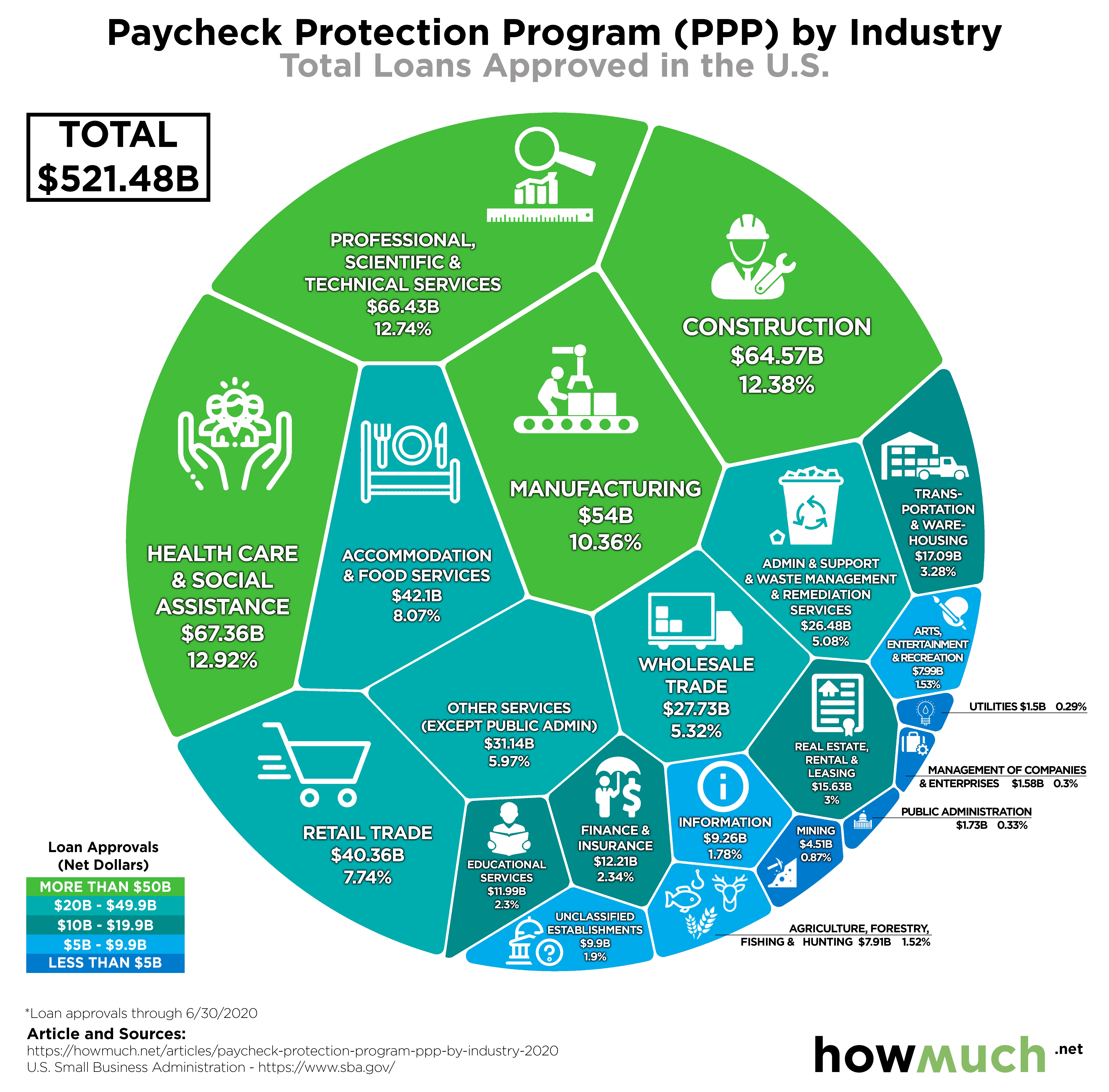Congress is returning to the Capitol to discuss another round of economic stimulus as the coronavirus pandemic rages on across the South and West. Nancy Pelosi wants more than $1.3T in aid, while Donald Trump says he wants a payroll tax cut. With the deficit already climbing to dizzying heights at $864B in June, it might be helpful to pause and consider which industries are benefiting the most from all this spending.
- Health care and social assistance organizations received more money than any other industry in the Paycheck Protection Program (PPP) at $67.36B, or 12.92% of the program’s total.
- 3 industries other than health care also received more than $50B, including professional services ($66.43B), construction ($64.57B) and manufacturing ($54B).
- Companies working in educational services got comparatively little funding at just $11.99B or 2.34% of the total.
- A lot of industries received lesser amounts, like utilities ($1.5B) and mining ($4.51B), demonstrating how the PPP is impacting diverse segments in the economy.
We found the data for our visualization directly from the U.S. Small Business Administration’s report on the Paycheck Protection Program (PPP). The PPP is a uniquely American response to the forced lockdowns and business closures resulting from the coronavirus pandemic. The government guaranteed forgivable loans to small businesses impacted by the virus if they kept workers on the payrolls. Businesses could apply for these loans through banks. You can find all the details about PPP, including limits and conditions, from the SBA. Our visualization highlights the specific industries benefiting the most from the $521.48B in PPP loans as of June 30, 2020.
Top 10 Industries Receiving PPP Assistance
- Health Care & Social Assistance: $67.36B or 12.92%
- Professional, Scientific & Technical Services: $66.43B or 12.74%
- Construction: $64.57B or 12.38%
- Manufacturing: $54B or 10.36%
- Accommodation & Food Services: $42.1B or 8.07%
- Retail Trade: $40.36B or 7.74%
- Wholesale Trade: $27.73B or 5.32%
- Administrative & Waste Management: $26.48B or 5.08%
- Transportation & Warehousing: $17.9B or 3.28%
- Real Estate, Rental & Leasing: $15.63B or 3%
Health care and social assistance companies are obvious standouts for direct government funding. Working on the frontlines of the coronavirus pandemic merits additional government money, and at $67.36B, this industry is taking home the largest percentage of PPP aid (12.92%). The other industries at the top of the list also make a lot of sense. Scientific, technical and professional services ($66.43B), construction ($64.57B) and manufacturing ($54B) all cover huge segments of the workforce. The pandemic is also hitting the food services ($42.1B) and retail ($40.36B) industries especially hard. In fact, our visualization makes it clear how the PPP is impacting a wide variety of industries, providing another indication of the breadth of disruption to the workforce.
A lot of different industries are benefiting from PPP, but there are still a few controversies in the disbursement of government aid. For starters, educational services and schools received relatively little money and are now a major flashpoint in the debate around additional stimulus funding. Big banks are also benefiting as the middlemen in the disbursement of PPP money, raising fees for their services and giving well-connected clients concierge treatment. Other questionable loans through PPP are now emerging. To give just two examples, Kanye West’s Yeezy received a multimillion dollar loan, and so did some hedge funds.
So the PPP has some problems, but it’s clear that a wide variety of industries and companies are benefiting from the rush to get stimulus into the economy. What do you think will happen with the next round of government stimulus? Let us know in the comments.
Do you need insurance for your business? Don't worry, we've got you covered.
Check Our Business Insurance Guides
General Liability Insurance Cost
Errors & Omissions Insurance Cost
Legal Malpractice Insurance Cost
Business Insurance Cost for Startups
Medical Malpractice Insurance Cost
Commercial Property Insurance Cost
Product Liability Insurance Cost
Data: Table 1.1
About the article
Authors
Irena - Editor





